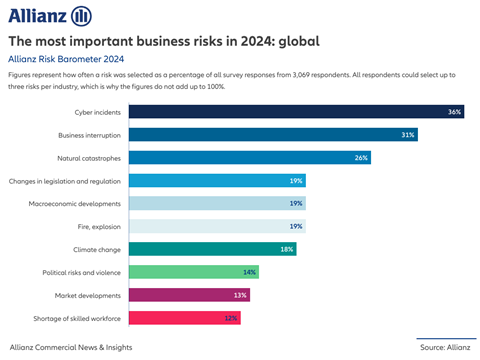A new barometer identifies the biggest threats to organisations wordwide as cyber, business interruption, and nat cats. Here are the report’s top tips for managing the risks
Cyber incidents such as ransomware attacks, data breaches, and IT disruptions are the biggest worry for companies globally in 2024, according to the latest Allianz Risk Barometer.
The closely interlinked peril of business interruption ranks second. Natural catastrophes (up from #6 to #3 year-on-year), fires and explosion (up from #9 to #6), and political risks and violence (up from #10 to #8) are the biggest risers.


The top global business risks are based on the insights of more than 3,000 risk management professionals worldwide.
Allianz Commercial CEO Petros Papanikolaou comments on the findings: “The top risks and major risers in this year’s Allianz Risk Barometer reflect the big issues facing companies around the world right now – digitalisation, climate change and an uncertain geopolitical environment.
Trends driving cyber activity in 2024
Cyber incident ranks as the most important risk globally for the third year in a row – for the first time by a clear margin.
It is the top peril in 17 countries, including Australia, France, Germany, India, Japan, the UK, and the USA.
A data breach is seen as the most concerning cyber threat for Allianz Risk Barometer respondents (59%) followed by attacks on critical infrastructure and physical assets (53%).
The recent increase in ransomware attacks – 2023 saw a worrying resurgence in activity, with insurance claims activity up by more than 50% compared with 2022 – ranks third (53%).
“Cyber criminals are exploring ways to use new technologies such as generative artificial intelligence (AI) to automate and accelerate attacks, creating more effective malware and phishing.
“The growing number of incidents caused by poor cyber security, in mobile devices in particular, a shortage of millions of cyber security professionals, and the threat facing smaller companies because of their reliance on IT outsourcing are also expected to drive cyber activity in 2024,“ explains Scott Sayce, global head of cyber, Allianz Commercial.
What does it mean for businesses?
Large corporates, mid-size, and smaller businesses are united by the same risk concerns – they are all mostly worried about cyber, business interruption and natural catastrophes.
However, the resilience gap between large and smaller companies is widening, as risk awareness among larger organisations has grown since the pandemic with a notable drive to upgrade resilience, the report notes.
Conversely, smaller businesses often lack the time and resources to identify and effectively prepare for a wider range of risk scenarios and, as a result, take longer to get the business back up and running after an unexpected incident.
Spotlight on nat cat threats and how they impact companies
Natural catastrophes (26%) is one of the biggest movers rising by three positions to third place.
2023 was a record-breaking year on several fronts. It was the hottest year since records began, while insured losses exceeded US$100bn for the fourth consecutive year, driven by the highest ever damage bill of US$60bn from severe thunderstorms.
Around the world, natural catastrophes is the #1 risk in Croatia, Greece, Hong Kong, Hungary, Malaysia, Mexico, Morocco, Slovenia, and Thailand, many of which sustained some of the most significant events of 2023.
In Greece, a wildfire near the city of Alexandroupolis in August was the largest ever recorded in the EU. Meanwhile, severe flooding in Slovenia resulted in one of the biggest supply chain events, causing production delays and parts shortages for European car manufacturers.
Physical damage to corporate assets from more frequent and severe extreme weather events are a key threat. The utility, energy and industrial sectors are among the most exposed.
In addition, net zero transition risks and liability risks are expected to increase in future as companies invest in new, largely untested low-carbon technologies to transform their business models.
How to tackle the threats
Allianz says that many of these risks are already hitting home, with extreme weather, ransomware attacks and regional conflicts expected to test the resilience of supply chains and business models further in 2024.
Companies should be aware and adjust their insurance covers accordingly.
Top tips for managing some of the key barometer risk:
- Cyber: Preventing a cyber-attack is becoming harder, and the stakes are higher. As a result, early detection and response capabilities and tools are becoming ever more important. Investment in detection backed by AI should also help to catch more incidents earlier. If companies do not have effective early detection tools this can lead to longer unplanned downtime, increased costs and have a greater impact on customers, revenue and reputation.
- Business interruption: This risk retains its position as the second biggest threat in the 2024 survey. This result reflects the interconnectedness in an increasingly volatile global business environment, as well as a strong reliance on supply chains for critical products or services. Improving business continuity management, identifying supply chain bottlenecks, and developing alternative suppliers should continue to be key risk management priorities for companies in 2024. In a fast-changing world, companies need to maintain regular audits of systems and to test their business continuity plans.
- Nat cats: Socioeconomic factors, such as increasing urbanisation in areas exposed to climate change, are a driver of nat cat insurance losses. With extreme weather events the new normal, companies need to invest in shoring up their supply chains. They need to focus on resilience such as flood protection and reinforcing infrastructure to reduce the vulnerability of assets, lower the risk of disruption, and increase insurability.
- Changes in legislation and regulation: Organisations will face new rules and regulations in 2024 that will not only require a high administrative burden but could also impose real restrictions on their business activities. “Companies need a strategic response to this that goes beyond monitoring the legislative process. A high level of uncertainty calls for scenario planning, strengthening resilience and open communication with internal and external stakeholders,” says Ludovic Subran, chief economist at Allianz.
- Fire: Although fire risks are well understood and typically well risk managed, fire remains a significant cause of business interruption (BI) and supply chain disruption, especially where critical components are concentrated geographically and among a small number of suppliers. Regularly assessing and updating prudent fire mitigation practices, including preventative measures, fire extinguishing methods and contingency planning remain essential for all businesses to lower the risk of loss from an incident.
Regional differences
Climate change (18%) may be a non-mover year-on-year at #7 but is among the top three business risks in countries such as Brazil, Greece, Italy, Turkey, and Mexico.
In a global context, the shortage of skilled workforce (12%) is seen as a lower risk than in 2023, dropping from #8 to #10.
However, businesses in Central and Eastern Europe, the UK and Australia identify it as a top five business risk.
Given there is still record low unemployment in many countries around the globe, companies are looking to fill more jobs than there are people available to fill them.
IT or data experts are seen as the most challenging to find, making this issue a critical aspect in the fight against cyber-crime.




















No comments yet